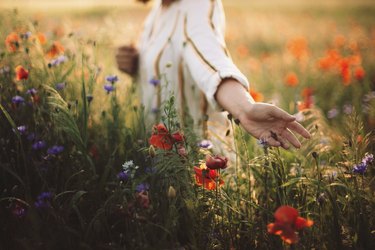
Believe it or not, flowers and humans have a lot in common. From similarities at the cellular level to common biological processes, plants and humans (and most animals, for that matter) have more alike than different.
Plant and Animal Cells
Video of the Day
On a basic biological level, humans and flowers (and other plants) have similar cells. The cells of a plant are eukaryotic, which means they have a true distinct nucleus along with other organelles. Each organelle carries out a different function. One of these organelles is the chloroplast, which carries out photosynthesis for a plant.
Video of the Day
Photosynthesis is the anabolic process by which plants collect energy from sunlight and turn it into chemical energy for life processes. They use carbon dioxide and release oxygen to do so. Plant cells also have a central vacuole and a cell wall. Animal cells do not have chloroplasts, central vacuoles or cell walls. However, most other organelles within animal cells are the same or similar to those in plant cells.
Photosynthesis and Respiration
Though animals do not undertake photosynthesis, they carry out the similar process of cellular respiration (plants technically carry out cellular respiration as well). During respiration, a catabolic process, chemical energy stored in glucose is released to provide energy in the form of adenosine triphosphate for a cell. Respiration requires the input of oxygen and glucose, and the output is carbon dioxide and energy.
Though the processes for energy production differ in plants and animals, they are in a sense the inverse of one another and rely on the opposite process in order to be effective. Oxygen produced by plants during photosynthesis is breathed in by humans and is the input for cellular respiration. Our carbon dioxide output is important to plants during photosynthesis.
Similarities Between Flowers and Humans
There are a number of other ways in which flowers are similar to humans, with slight variations. Like humans, plants respond to thermal stress and sunlight levels. While humans can simply get up and walk away, plants have other coping mechanisms, like shriveling up their leaves to absorb less light on a sunny day.
Plants and humans both reproduce to ensure the continuation of the species. Plants reproduce through the process of pollination. In a very general sense, when bees, butterflies and other pollinators bring a flower's pollen from the anther (male part) of one plant to the pistil (female part) of the next, the process has begun. The pollen needs to move from the stigma at the top of the flower's pistil down the style and to the ovary in order for fertilization to be complete. In most plants, fruit is actually the ripened ovary of a plant that grows after having been fertilized. The ovary swells to protect the seeds inside, which are actually small embryos. When fruits decompose, their seeds return to the earth and can grow new plants.
All reproductive processes are similar in plants and humans. Humans, of course, have reproductive systems that are distinctly male or female at birth, and female humans have ovaries. The fertilization by a male human is what allows the contents of a female's ovaries to grow into offspring.